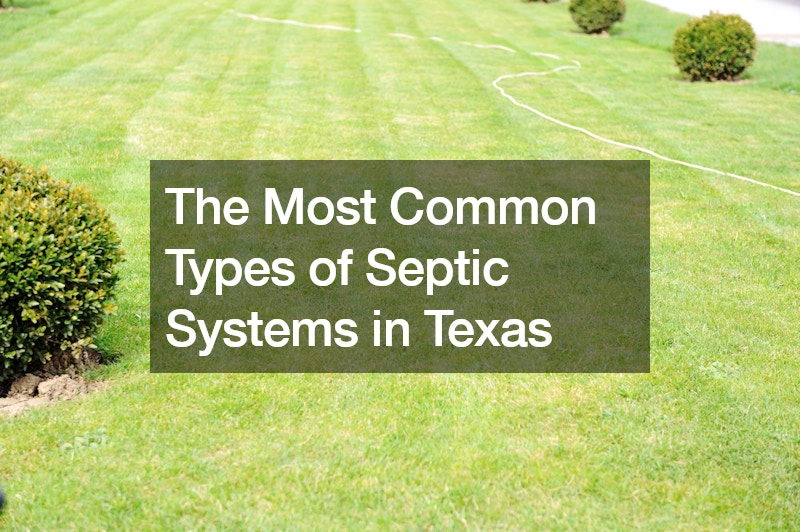
The Most Common Types of Septic Systems in Texas
Septic systems are a crucial part of wastewater management for many homes in Texas, especially in rural areas where access to municipal sewer lines is not feasible. These systems are designed to treat and dispose of wastewater on-site, making them an essential part of residential infrastructure. Given the variety of soil types, climate conditions, and property sizes in Texas, it is important to understand the different types of septic systems available. Each type of system has its own set of benefits and drawbacks, making it essential to choose the one that best fits your specific needs. This article aims to explore the most common types of septic systems in Texas, along with some useful tips on how to maintain them and recognize when you might need a new installation. We’ll also discuss other relevant considerations like plumbing installation and garden watering systems to give you a comprehensive understanding of your options.
The Aerobic Drip System

The Aerobic Drip System is a popular choice for homeowners who are concerned about the quality of effluent being released into the environment. This system uses aerobic bacteria to break down waste, which is much more effective than the anaerobic bacteria used in conventional septic systems. As a result, the effluent that is released is much cleaner and safer for the environment. The system utilizes a series of small diameter drip irrigation lines to distribute the treated effluent evenly across a larger area of soil.
One of the key advantages of the Aerobic Drip System is its efficiency. It can be used in various soil types, including those that are not suitable for conventional systems. This makes it an ideal choice for many homes in Texas. Additionally, the system requires less space compared to other types of septic systems, making it a good option for homes with limited yard space. Sewer line repair and maintenance are also minimized because the system is designed to handle variations in wastewater flow more effectively.
However, the Aerobic Drip System does require regular maintenance to function correctly. This includes periodic inspections and pump-outs to ensure that the system is operating efficiently. Due to the complexity of the system, professional servicing is recommended. Homeowners should consider these maintenance requirements when deciding whether this type of system is right for them. Overall, the Aerobic Drip System is a versatile and efficient choice for wastewater management in Texas.
The Aerobic Spray System
The Aerobic Spray System is another efficient type of septic system that is commonly used in Texas. Similar to the Aerobic Drip System, it uses aerobic bacteria to treat wastewater. The primary difference is in how the treated effluent is dispersed. In the Aerobic Spray System, the treated effluent is sprayed onto the surface of the yard rather than being distributed through drip irrigation lines. This method of dispersal can be highly effective in areas with sufficient space for spraying.
One of the main benefits of the Aerobic Spray System is its ability to handle high volumes of wastewater. This makes it a suitable option for larger homes or properties with more occupants. The system is also relatively easy to install and maintain. Septic tank replacement is generally straightforward, and regular septic pumping service ensures that the system functions efficiently. Additionally, the system can be used in a variety of soil types, making it a versatile choice for many Texas homeowners.
However, the Aerobic Spray System does have some drawbacks. The spraying of treated effluent can create odors, which may be a concern for some homeowners. It is also important to ensure that the spray nozzles are properly maintained to prevent clogging and ensure even distribution of the effluent. Despite these considerations, the Aerobic Spray System remains a popular and effective option for wastewater management in Texas.
The Low-Pressure Dosing System

The Low-Pressure Dosing System is designed to provide a steady and controlled release of treated wastewater into the soil. This system uses a pump to disperse the effluent at low pressure, allowing for better distribution and absorption. It is particularly effective in areas with shallow soils or poor drainage. The system involves a network of small-diameter pipes that evenly distribute the effluent throughout the leach field.
One of the main advantages of the Low-Pressure Dosing System is its ability to function in a variety of soil conditions. This makes it a practical option for many properties in Texas where conventional systems might not work as effectively. The system also requires less space compared to other types of septic systems, making it ideal for homes with limited yard space. Additionally, the controlled release of effluent reduces the risk of system overload and failure, minimizing the need for costly repipes and other repairs.
However, the Low-Pressure Dosing System does require regular maintenance to ensure optimal performance. This includes routine inspections and pump-outs to prevent clogs and buildup. Homeowners should be aware of these maintenance needs when considering this type of system. Overall, the Low-Pressure Dosing System is a reliable and efficient choice for wastewater management, particularly in challenging soil conditions.
Sand Filter Systems

Sand Filter Systems are an effective option for treating wastewater in areas with poor soil conditions. This system involves the use of sand as a natural filter to treat the effluent before it is dispersed into the soil. The effluent is first treated in a septic tank and then pumped into a sand filter. As the wastewater percolates through the sand, impurities are removed, resulting in cleaner effluent being released into the environment.
One of the main benefits of Sand Filter Systems is their ability to provide high-quality treatment of wastewater. This makes them an excellent choice for properties with sensitive environmental conditions or where groundwater protection is a concern. Additionally, sand filter systems can be used in conjunction with other types of septic systems to enhance their effectiveness. For example, a system designed primarily for solid waste management can benefit from the added filtration provided by a sand filter. Regular sewer camera inspection is also recommended to ensure that the system is functioning properly.
However, Sand Filter Systems do require regular maintenance to keep them operating efficiently. This includes periodic cleaning and replacement of the sand filter material. Homeowners should be prepared for these maintenance requirements when considering a sand filter system. Overall, Sand Filter Systems offer a reliable and effective solution for wastewater management in areas with challenging soil conditions.
The Conventional Drain Field System

The Conventional Drain Field System is one of the most common types of septic systems used in Texas. This system involves the use of a septic tank to treat wastewater, which is then dispersed into a drain field through a series of perforated pipes. The drain field allows the treated effluent to percolate through the soil, where further treatment occurs naturally. This type of system is well-suited for properties with well-draining soils and sufficient space for a drain field.
One of the primary advantages of the Conventional Drain Field System is its simplicity and reliability. This system has been used for decades and is well-proven in its effectiveness. It requires minimal maintenance compared to some of the more advanced types of septic systems. Homeowners can expect lower costs for installation and upkeep, making it a cost-effective option. Additionally, the system can be adapted to various property sizes and layouts, making it a versatile choice for many Texas homes.
However, the Conventional Drain Field System may not be suitable for all properties. Homes with poorly draining soils or limited yard space may require an alternative system. Regular inspections and maintenance are also necessary to ensure that the system continues to function properly. Homeowners should also consider installing a patio or other landscaping features that do not interfere with the drain field area. Overall, the Conventional Drain Field System remains a popular and effective option for wastewater management in Texas.
Mound Systems
Mound Systems are designed to provide effective wastewater treatment in areas with difficult soil conditions. This system involves the construction of a mound of sand and gravel above the natural soil to create a suitable environment for wastewater treatment. The effluent is first treated in a septic tank and then pumped into the mound, where it is further treated as it percolates through the sand and gravel layers. This process ensures that the treated effluent is safely dispersed into the environment.
One of the key benefits of Mound Systems is their ability to function in areas with shallow bedrock, high groundwater tables, or poorly draining soils. This makes them a practical option for many properties in Texas where conventional systems may not work effectively. Additionally, Mound Systems require less space compared to other types of septic systems, making them suitable for homes with limited yard space. Regular septic pumping service is essential to maintain the system’s efficiency and prevent overloading.
However, Mound Systems do require regular maintenance to ensure optimal performance. This includes periodic inspections, pump-outs, and monitoring of the mound’s condition. Homeowners should be aware of these maintenance needs when considering a Mound System for their property. Overall, Mound Systems offer a reliable and effective solution for wastewater management in challenging soil conditions.
Signs You Need a New Installation
Recognizing when it’s time for a new septic system installation is crucial for maintaining the health and safety of your property. One of the most obvious signs is frequent septic system failures or backups. If you find yourself constantly dealing with plumbing issues, it might be time to consider a new installation. These issues can manifest as slow drains, sewage backups, or even pooling water in your yard. In such cases, consulting with a professional for sewer line repair or septic tank replacement is essential.
Another sign that you might need a new septic system is the presence of unpleasant odors around your property. Persistent smells of sewage or wastewater can indicate that your current system is not functioning properly. This could be due to a variety of factors, including a failing drain field or a clogged system. Regular inspections, including sewer camera inspection, can help identify the root cause of these issues and determine if a new installation is necessary.
Lastly, aging systems are more prone to failures and may require replacement. If your septic system is over 20-30 years old, it may be reaching the end of its lifespan. In such cases, investing in a new system can save you money in the long run by preventing frequent repairs and ensuring efficient wastewater management. Recognizing these signs and addressing them promptly can help maintain the health and safety of your home and property.
How to Choose the Ideal Septic System for Your Property
Choosing the ideal septic system for your property involves considering several factors, including soil type, property size, and local regulations. One of the first steps is to conduct a soil test to determine the suitability of different types of septic systems in Texas for your property. Soil conditions play a significant role in how well a septic system can function, and understanding this can help you make an informed decision. Consulting with a professional for plumbing installation can also provide valuable insights.
Another important factor to consider is the size of your property and the number of occupants in your home. Larger properties with more occupants may require a system that can handle higher volumes of wastewater. Systems like the Aerobic Spray System or Low-Pressure Dosing System may be more suitable for such homes. On the other hand, smaller properties might benefit from systems like the Aerobic Drip System or Sand Filter Systems. These systems are efficient and require less space, making them ideal for smaller properties.
Local regulations and permits are also essential considerations when choosing a septic system. Different areas in Texas may have specific requirements and guidelines for septic system installation and maintenance. Ensuring that your chosen system complies with these regulations can prevent potential legal issues and fines. Consulting with local authorities or professionals can help you navigate these requirements and choose the ideal septic system for your property.
Other Systems to Consider When Installing Septic Systems
Beyond traditional septic systems, there are other systems to consider that can complement your wastewater management setup. One such system is the garden watering system, which can be integrated with certain types of septic systems. Using treated effluent for garden irrigation can be an environmentally friendly way to reuse wastewater while providing essential nutrients to your plants. This can be particularly beneficial in arid regions of Texas where water conservation is crucial. It’s best to minimize water usage especially if your property is prone to issues leaking water heaters or other issues.
Another system to consider is a rainwater harvesting system. This system collects and stores rainwater for various uses, including irrigation, car washing, and even as a backup water supply. Integrating a rainwater harvesting system with your septic system can help reduce water consumption and lower utility bills. It also provides a sustainable way to manage water resources on your property. Regular maintenance and inspections are necessary to ensure that both systems function efficiently.
Finally, consider the addition of a greywater recycling system. This system collects and treats greywater from household activities like laundry, dishwashing, and bathing. The treated greywater can then be used for tasks like garden irrigation or toilet flushing. Integrating a greywater recycling system with your septic system can further enhance water conservation efforts and reduce the strain on your primary wastewater treatment system. These additional systems offer a holistic approach to water management and can complement the types of septic systems in Texas.
Managing a Septic System and Well
Managing a septic system and well simultaneously requires a comprehensive approach to ensure the health and safety of your water supply. Regular inspections and maintenance are crucial for both systems. For your septic system, this includes routine pump-outs, sewer camera inspections, and monitoring for signs of failure. These steps help prevent issues like clogs, backups, and system overloads, ensuring efficient wastewater treatment and disposal.
For your well, regular testing is essential to ensure water quality. Testing for contaminants like bacteria, nitrates, and heavy metals can help identify potential issues before they become serious health risks. Water well drillers can provide professional testing services and recommend appropriate treatment options if contaminants are found. Ensuring that your well is properly sealed and maintained can also prevent contamination from the surrounding environment, including your septic system.
Proper placement and separation of your septic system and well are also critical. Ensuring that the septic system is installed at a safe distance from the well can prevent cross-contamination. Local health regulations typically provide guidelines for the minimum distance required between these systems. Adhering to these guidelines and consulting with professionals can help ensure that both systems function effectively and safely, protecting your water supply and overall property health.
Conclusion
In conclusion, understanding the different types of septic systems in Texas is crucial for choosing the best option for your property. Each system offers unique benefits and challenges, from the efficient Aerobic Drip and Aerobic Spray Systems to the reliable Conventional Drain Field System. Special considerations such as soil type, property size, and local regulations play significant roles in determining the most suitable system. Regular maintenance and inspections are essential to ensure optimal performance and longevity of your septic system, preventing issues like clogs, backups, and environmental contamination. Additional systems like garden watering systems and greywater recycling can complement your septic system, offering sustainable solutions for water management. Recognizing signs that indicate the need for a new installation, such as frequent failures or unpleasant odors, can help you take timely action to protect your property. Lastly, properly managing both your septic system and well ensures the safety and quality of your water supply, adhering to local health guidelines and professional recommendations. By considering all these factors, you can make an informed decision and maintain an efficient wastewater management system for your home.

